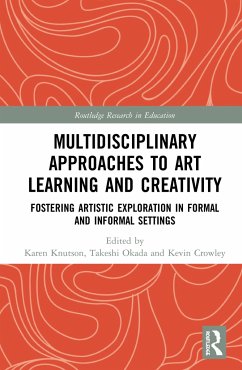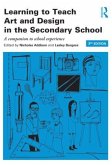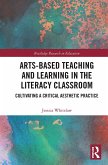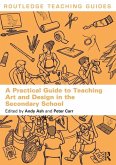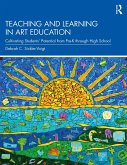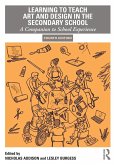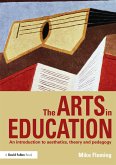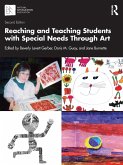Multidisciplinary Approaches to Art Learning and Creativity
Fostering Artistic Exploration in Formal and Informal Settings
Herausgeber: Knutson, Karen; Crowley, Kevin; Okada, Takeshi
Multidisciplinary Approaches to Art Learning and Creativity
Fostering Artistic Exploration in Formal and Informal Settings
Herausgeber: Knutson, Karen; Crowley, Kevin; Okada, Takeshi
- Gebundenes Buch
- Merkliste
- Auf die Merkliste
- Bewerten Bewerten
- Teilen
- Produkt teilen
- Produkterinnerung
- Produkterinnerung
This book explores learning in the arts and highlights ways in which art and creativity can ignite learning in schools, informal learning spaces, and higher education. The focus is on learning in, with, and through the arts.
Andere Kunden interessierten sich auch für
![Learning to Teach Art and Design in the Secondary School Learning to Teach Art and Design in the Secondary School]() Learning to Teach Art and Design in the Secondary School59,99 €
Learning to Teach Art and Design in the Secondary School59,99 €![Arts-Based Teaching and Learning in the Literacy Classroom Arts-Based Teaching and Learning in the Literacy Classroom]() Jessica WhitelawArts-Based Teaching and Learning in the Literacy Classroom36,99 €
Jessica WhitelawArts-Based Teaching and Learning in the Literacy Classroom36,99 €![A Practical Guide to Teaching Art and Design in the Secondary School A Practical Guide to Teaching Art and Design in the Secondary School]() Andy AshA Practical Guide to Teaching Art and Design in the Secondary School63,99 €
Andy AshA Practical Guide to Teaching Art and Design in the Secondary School63,99 €![Teaching and Learning in Art Education Teaching and Learning in Art Education]() Debrah C. Sickler-Voigt (USA Middle Tennessee State University)Teaching and Learning in Art Education91,99 €
Debrah C. Sickler-Voigt (USA Middle Tennessee State University)Teaching and Learning in Art Education91,99 €![Learning to Teach Art and Design in the Secondary School Learning to Teach Art and Design in the Secondary School]() Learning to Teach Art and Design in the Secondary School41,99 €
Learning to Teach Art and Design in the Secondary School41,99 €![The Arts in Education The Arts in Education]() Mike Fleming (UK University of Durham)The Arts in Education51,99 €
Mike Fleming (UK University of Durham)The Arts in Education51,99 €![Reaching and Teaching Students with Special Needs Through Art Reaching and Teaching Students with Special Needs Through Art]() Reaching and Teaching Students with Special Needs Through Art80,99 €
Reaching and Teaching Students with Special Needs Through Art80,99 €-
-
-
This book explores learning in the arts and highlights ways in which art and creativity can ignite learning in schools, informal learning spaces, and higher education. The focus is on learning in, with, and through the arts.
Hinweis: Dieser Artikel kann nur an eine deutsche Lieferadresse ausgeliefert werden.
Hinweis: Dieser Artikel kann nur an eine deutsche Lieferadresse ausgeliefert werden.
Produktdetails
- Produktdetails
- Routledge Research in Education
- Verlag: Taylor & Francis Inc
- Seitenzahl: 298
- Erscheinungstermin: 3. September 2020
- Englisch
- Abmessung: 235mm x 157mm x 21mm
- Gewicht: 568g
- ISBN-13: 9780815361886
- ISBN-10: 0815361882
- Artikelnr.: 59989491
- Herstellerkennzeichnung
- Books on Demand GmbH
- In de Tarpen 42
- 22848 Norderstedt
- info@bod.de
- 040 53433511
- Routledge Research in Education
- Verlag: Taylor & Francis Inc
- Seitenzahl: 298
- Erscheinungstermin: 3. September 2020
- Englisch
- Abmessung: 235mm x 157mm x 21mm
- Gewicht: 568g
- ISBN-13: 9780815361886
- ISBN-10: 0815361882
- Artikelnr.: 59989491
- Herstellerkennzeichnung
- Books on Demand GmbH
- In de Tarpen 42
- 22848 Norderstedt
- info@bod.de
- 040 53433511
Karen Knutson is co-lead of the University of Pittsburgh Center for Learning in Out of School Environments (UPCLOSE), USA. Takeshi Okada is Professor of Psychology and Cognitive Science at the Graduate School of Education and Graduate School of Interdisciplinary Information Studies at the University of Tokyo, Japan. Kevin Crowley is Professor of Education at the University of Pittsburgh and co-lead of University of Pittsburgh Center for Learning in Out of School Environments (UPCLOSE), USA.
Section 1: Exploring the nature of art practice and art learning 1.Art
appreciation for inspiration and creation2. Embodying artistic process in
art gallery visits. 3. Relaxation and Reorganization of "Internal
Constraints" in Artistic Creation: Studies Focusing on the Embodiment of
Ideas and Interaction with Others in Breakdance 4. Stories: Trauma, Theater
and Theory 5. The centrality of artistic practice to learning in the art
museum. Section 2: Designing for teaching and learning 6. Flexibility and
social interactions: Two exercises to help art students to be more creative
7. Teaching Composition with Digital Tools: A Domain-Specific Perspective
8. Integrating Poïétique and cognitive science to analyze the creativity
learning process in a drawing course for art education majors 9. The Role
of Critique in the Development of Student-Artists Metacognitive Practices
Section 3: Systems for change in art learning and art education 10.
Learning to be creative through the arts in Danish artist-school
partnerships 11. Approaching art education as an ecology: Exploring the
role of museums. 12. A different kind of learning: The value of a studio
art class for Non-art graduate students 13. Growing up with art: How
interest, opportunity and support shape learning pathways of visual arts
professionals.
appreciation for inspiration and creation2. Embodying artistic process in
art gallery visits. 3. Relaxation and Reorganization of "Internal
Constraints" in Artistic Creation: Studies Focusing on the Embodiment of
Ideas and Interaction with Others in Breakdance 4. Stories: Trauma, Theater
and Theory 5. The centrality of artistic practice to learning in the art
museum. Section 2: Designing for teaching and learning 6. Flexibility and
social interactions: Two exercises to help art students to be more creative
7. Teaching Composition with Digital Tools: A Domain-Specific Perspective
8. Integrating Poïétique and cognitive science to analyze the creativity
learning process in a drawing course for art education majors 9. The Role
of Critique in the Development of Student-Artists Metacognitive Practices
Section 3: Systems for change in art learning and art education 10.
Learning to be creative through the arts in Danish artist-school
partnerships 11. Approaching art education as an ecology: Exploring the
role of museums. 12. A different kind of learning: The value of a studio
art class for Non-art graduate students 13. Growing up with art: How
interest, opportunity and support shape learning pathways of visual arts
professionals.
Section 1: Exploring the nature of art practice and art learning 1.Art
appreciation for inspiration and creation2. Embodying artistic process in
art gallery visits. 3. Relaxation and Reorganization of "Internal
Constraints" in Artistic Creation: Studies Focusing on the Embodiment of
Ideas and Interaction with Others in Breakdance 4. Stories: Trauma, Theater
and Theory 5. The centrality of artistic practice to learning in the art
museum. Section 2: Designing for teaching and learning 6. Flexibility and
social interactions: Two exercises to help art students to be more creative
7. Teaching Composition with Digital Tools: A Domain-Specific Perspective
8. Integrating Poïétique and cognitive science to analyze the creativity
learning process in a drawing course for art education majors 9. The Role
of Critique in the Development of Student-Artists Metacognitive Practices
Section 3: Systems for change in art learning and art education 10.
Learning to be creative through the arts in Danish artist-school
partnerships 11. Approaching art education as an ecology: Exploring the
role of museums. 12. A different kind of learning: The value of a studio
art class for Non-art graduate students 13. Growing up with art: How
interest, opportunity and support shape learning pathways of visual arts
professionals.
appreciation for inspiration and creation2. Embodying artistic process in
art gallery visits. 3. Relaxation and Reorganization of "Internal
Constraints" in Artistic Creation: Studies Focusing on the Embodiment of
Ideas and Interaction with Others in Breakdance 4. Stories: Trauma, Theater
and Theory 5. The centrality of artistic practice to learning in the art
museum. Section 2: Designing for teaching and learning 6. Flexibility and
social interactions: Two exercises to help art students to be more creative
7. Teaching Composition with Digital Tools: A Domain-Specific Perspective
8. Integrating Poïétique and cognitive science to analyze the creativity
learning process in a drawing course for art education majors 9. The Role
of Critique in the Development of Student-Artists Metacognitive Practices
Section 3: Systems for change in art learning and art education 10.
Learning to be creative through the arts in Danish artist-school
partnerships 11. Approaching art education as an ecology: Exploring the
role of museums. 12. A different kind of learning: The value of a studio
art class for Non-art graduate students 13. Growing up with art: How
interest, opportunity and support shape learning pathways of visual arts
professionals.

